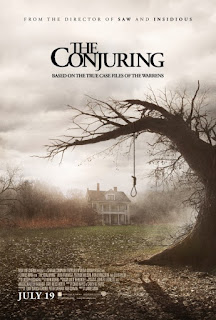 |
| Rated R for sequences of disturbing violence and terror |
The Conjuring is a great film, no question about it. The scares are extremely effective and steadily built upon to make reveals even more terrifying. Each scare sequence peels back layers that make the next build-up tenser as it leads to a scare that peels back more layers, culminating in a terrifying and exciting finale. Much like Jaws, the suspense and terror comes from knowing what is the force at work without actually seeing it, and it is that idea of suggestibility that makes the film scarier than your average horror or Jason slasher.
James Wan (Saw, Insidious) uses lighting and colors to clue the audience in to what is good and bad, what is innocent and what is insidious. Towards the beginning of the film, Ed gives a tour of his museum of hellish artifacts, where he makes it very clear that what is in there is dangerous and the only reason they keep all of them at home with them is so they don't wreak havoc on anybody else. When he leaves the museum, his black shirt becomes apparent and starkly contrasts with his wife's white outfit; she stayed out of the museum and resembles the purity in contrast to the spiritual muck Ed was walking around. Other than the museum area, the Warrens' house is bright and inviting. Contrast this with the Perron's farm, which has a very dark aesthetic. Of course, that's where everything hits the fan. Whenever we were at the Warrens or a university they visit, I was relaxed. Whenever we were at the Perron's, I tensed up like a deer on the highway. The metaphorical fresh air made the terrifying sequences stand out as even more terrifying, much like we were only nervous about a shark during Jaws when there was a beach scene...or Brody was stuck in the middle of the ocean with a killer shark. It's a master craft.
Now back to the idea of suggestibility. There are certainly times when you see the demons and ghosts in The Conjuring (that is, if you're not covering your eyes), but one sequence that I can never forget is towards the climax when the demons strike back against the Warren family on a personal level: terrorizing their daughter. In this scene, tension is built by what is unseen. We hear banging, we hear silence, we see light. Then the light disappears and the darkness submerges the once-haven that is the Warrens' home; the creepy Annabelle doll is gone. The daughter tries to escape it by hiding in another room, but the darkness submerges that room and the banging returns, too. Then silence: all but a creaking. She turns around and there's a rocking chair with an old hag combing Annabelle. It is terrifying; for me, mostly because we never see the hag's face. In this scene and other scenes like it, such as the iconic clapping scene, our imagination, with the atmosphere and build-up, conjures up something so terrifying it must be inhuman.
The technical parts of the film are also strong. The makeup for the Bathsheba demon (Joseph Bishara, the film's composer) is terrifyingly disgusting and hellish, and when she possesses a character the merger is creepy. Overall, the makeup helps the dead (or supernatural) look otherwordly. Furthermore, the makeup department clues us in on the physical impact of the hauntings on this family, with the mother Carolyn (Lili Taylor, I Shot Andy Warhol, The Haunting) look worse and worse with each scene. The special effects are subtle and make the terror seem real and palpable. A lot of them are very low-key, so it stays intimately horrific instead of a SFX guy showing off what he can do on a computer; we've come a long way since the first Poltergeist. I have no idea how James Wan accomplished some of these shots--what is real and what is not--so major props there. The costuming helps put us in the 1970s period the film takes place in. Although sometimes, the dialogue's attempts to put us in the era aren't so "groovy," but the scene in question is light-hearted.
But where the dialogue isn't always so radical, the script makes up for it in characterization. The Warrens' relationship is so well-realized you can't help but get behind them. Furthermore, I found it especially interesting how they were characterized as devout Christians who believe they "were brought together for a reason." Lorraine's belief that the Perron case is the reason God put them together, as well as a dramatic flashback that explains why Ed is so concerned for Lorraine, really raises the emotional stakes for the final exorcism scene. Because of this, the finale isn't a conventional "gotta get the demon out" spectacle, but a emotional culmination of character arcs.
 |
| The Warrens are great characters, mostly due to how the film makes us care for them. |
Have you seen The Conjuring? What did you think about it? Are you anticipating The Conjuring 2? Whatever you have to say about me or the movies, comment below!
No comments:
Post a Comment